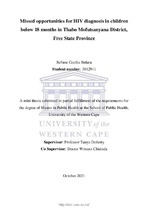| dc.description.abstract | Introduction
A high burden of Human Immunodeficiency Virus (HIV) constitutes a key global public health
concern. In South Africa, it is estimated that 260 000 children aged 0-14 years had HIV
infection and only 63% of them were reported to have received HIV treatment in 2018. Without
antiretroviral therapy (ART), HIV infection during infancy is associated with rapid disease
progression where more than half of all infected children are expected to die before two years
of age. Early infant diagnosis (EID) of HIV is therefore essential for accessing timely HIV
treatment. However, preanalytical errors within the EID diagnostic cascade prevent optimal
access to HIV polymerase chain reaction (PCR) results. The aim of this study was to describe
the prevalence and contributing factors of preanalytical errors resulting in missed diagnostic
opportunities for HIV among children below 18 months of age in Thabo Mofutsanyana (TM)
district.
Methodology
The study was conducted using a descriptive cross-sectional study design and data was
collected in two phases. Phase 1 involved obtaining the routine HIV PCR testing data set from
the National Health Laboratory Services (NHLS) for all samples collected at TM public health
facilities in 2018 and registered by NHLS. Phase 2 included a facility assessment checklist and
semi structured questionnaire administered to 36 health care workers (HCWs) from 10
purposively selected health facilities. Data collected in phase 2 was analyzed to describe health
facilities and HCW factors that might be contributing to the HIV PCR preanalytical errors.
Results
Phase 1. Of the 9318 samples included in the analysis, 49.6% were birth HIV PCRs whilst
42.1% and 8.3% were from 10 weeks and above 12 weeks age categories, respectively. A total
of 745 (8%) samples were rejected because of the following preanalytical errors: insufficient
specimen (84.3%), unsuitable sample (9.9%) and clerical error (5.8%).By age, the preanalytical
errors were: birth (534), 10 weeks (170) and the above 12 weeks age category (41). Hospitals
had the highest proportion of total preanalytical errors (58.1%). For PHCs the errors were:
insufficient specimen (90%), unsuitable sample (5.5%) and clerical (4.8%). | en_US |

